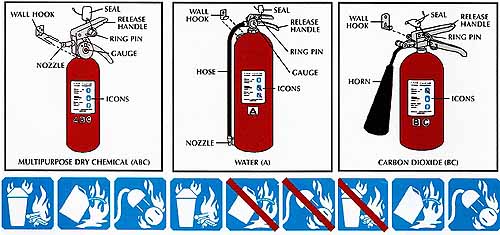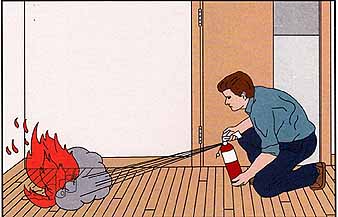Nearly everyone has had an unsettling experience with a minor household fire or the threat of one. Fires in their early stages, however, are often contained in a small space and maybe extinguished if attended to quickly
Quick Solutions: Flames in an oven many times can be put out by closing the door and turning off the heat. A grease fire in a pan can usually be extinguished by sliding a metal cover over the pan and turning off the heat. On an electric stove, move the pan to a cold burner. don't use water or try to carry a pan of flaming grease outside.
As with grease fires, never use water on an electrical fire. Often you can stop it before it gets well started by pulling the plug or turning off electricity at the service panel. Water is the best choice, how ever, on fires in mattresses or cushions. Douse the flames with a pan of water, and when the fire is out, carry the item outdoors and soak it thoroughly.
If your clothes catch fire, roll on the ground or floor to smother the flames—never run. When someone else’s clothes are aflame, force the victim down and roll the person over and over. Use a rug, blanket, or coat to help put out the flames. When the fire is out, call an ambulance.
Extinguishers: With a few exceptions, all of these small fires can be put out more safely with fire extinguishers. don't use an extinguisher on burning grease or burning clothes, however. and if the room is filled with smoke or the fire is fed by plastics or foam rubber—which often produces poisonous fumes—do not attempt to extinguish the fire. In all other cases, if a fire breaks out, alert others to leave the house and to call the fire department, then use an extinguisher (opposite, bottom). If the fire continues to burn after the extinguisher is empty, leave the room, close the door, and wait out side for the firefighters.
Hang fire extinguishers in several locations from hooks screwed to wall studs, and always in the kitchen, garage, and basement. Mount them in plain view near doorways, no more than 5 feet above the floor and as far as possible from spots where a fire is likely to start, such as a stove.

Multipurpose Dry Chemical (ABC); Water (A); Carbon Dioxide (BC). Wall
Hook, Seal, Release Handle, Ring Pin, Gauge, Horn, Nozzle. Hose
An arsenal of extinguishers. Household fires fall into three basic categories: A Class A fire is fed by a solid fuel such as paper or wood; a Class B fire involves a burning liquid such as gasoline or grease; and a Class C fire is one in a live electrical circuit.
Extinguishers—whether containing dry chemicals, water, or carbon dioxide—are labeled with icons representing the classes of fire for which they are intended (above). Each extinguisher has a ring pin or other safety device that immobilizes the release handle to prevent an accidental discharge. A seal, which is easily broken when the ring pin is removed, indicates whether the extinguisher has been used. Check the gauge once a month to see that the canister is fully charged.
THE RIGHT TYPE FOR EVERY BLAZE
Type of extinguisher |
Class of fire |
Capacity (lbs.) |
Range of stream (ft.) |
Discharge time (sec.) |
Advantages |
Limitations |
Multipurpose dry chemical |
ABC |
1—5 2½ 9—17 17—30 |
5—12 5—12 5—20 5—20 |
8—10 8—15 10—25 10—25 |
Can be used on all classes of fires; lightweight; inexpensive, |
May not completely extinguish a deep-seated upholstery fire; leaves residue; dry chemical vapor may hamper visibility. |
Pressured water |
A |
30 |
30—40 |
60 |
Longer discharge time; greater range. |
Must be protected from freezing; initial discharge may create more smoke, hampering visibility. |
Carbon dioxide |
BC |
2½-5 10—15 20 |
3—8 3—8 3—8 |
8—30 8—30 10—30 |
Leaves no residue. |
Dissipates in wind; carbon dioxide “snow” may burn skin; eliminates oxygen around immediate area. |
Selecting an extinguisher. Use the chart above to select fire extinguishers for your home. For complete protection, you will need more than one type. An extinguisher used against a class of fire for which it's not clearly labeled can actually increase the intensity of the fire.
Multipurpose dry-chemical models, though lighter and less expensive than other kinds, leave behind a powder that is difficult to clean up and that does not work as well against Class A fires as water does. A water extinguisher, though limited to Class A fires, lets you fight a fire longer and at a safer distance than do other types. Carbon dioxide extinguishers, more costly than dry-chemical or water models, leave no residue.
Buy only those approved by Underwriters Laboratories and at least the size of the smallest units in the chart. Larger units expel their contents at a faster rate to put out a fire quicker, and will put out a larger fire than the smaller units.
Attacking the Flames Safely

Targeting the fire.
• Pull the ring pin from the extinguisher to free the release handle.
• At 6 to 8 feet from the fire and with your back to the nearest exit, hold the extinguisher upright and point the nozzle at the base of the flames.
• Squeeze the handle and play the stream on the fire, sweeping slowly from side to side, until the fire is out.
• Watch the area to make sure the fire does not rekindle, and be prepared to spray again.
Previous: Building
Walls That Resist Flames
Next: Ladders to
Escape a House Fire